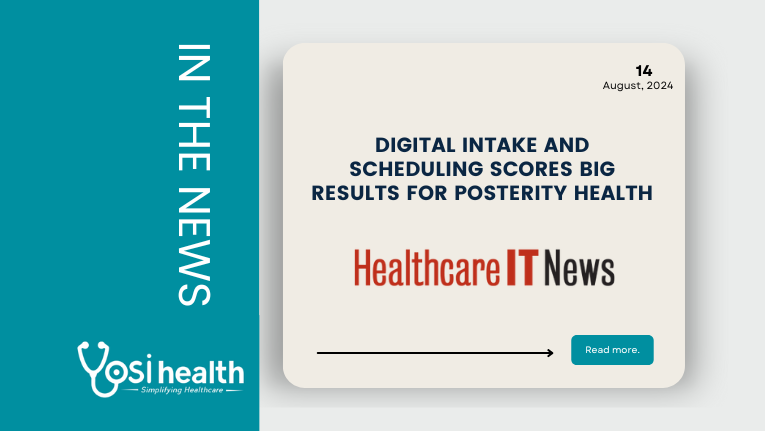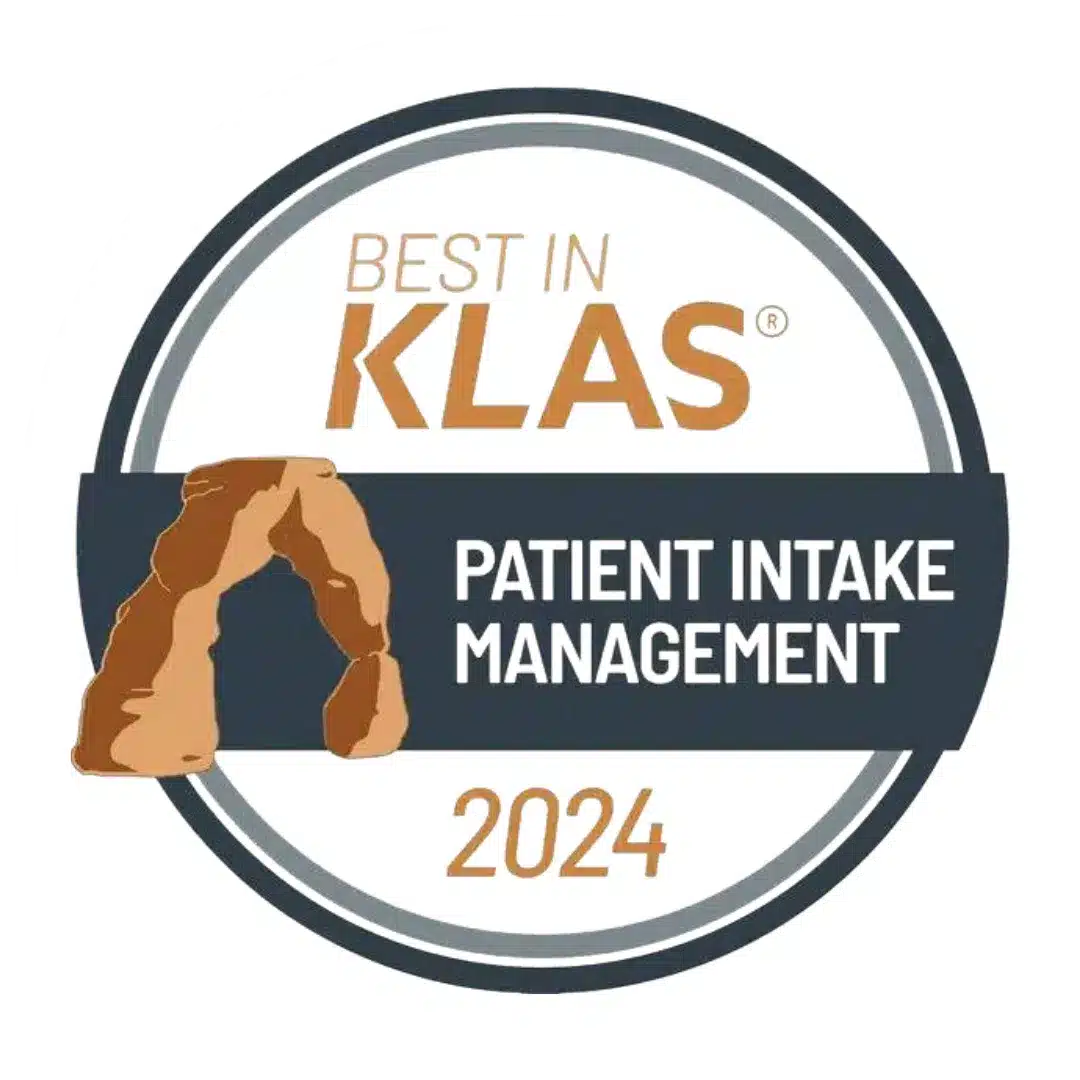
Digital intake and scheduling scores big results for Posterity Health
With the digital intake process, 70% of patients now complete their intake forms within 10 minutes. This efficiency has saved staff approximately 10 minutes per appointment, allowing them to focus more on patient care rather than paperwork.

Matt Alley, COO at Posterity Health, a digital male fertility clinic
Posterity Health is a virtual-first center of excellence for male reproductive health. It provides a hybrid care delivery model, allowing for telehealth appointments, ongoing treatment plans and in-person care. Through various technologies, personalized care and expert guidance, Posterity Health empowers males to take control of their reproductive health.
THE PROBLEM
Male reproductive healthcare is often overlooked, and there is a pervasive stigma associated with seeking help, said Matt Alley, COO at Posterity Health.
“Men generally are hesitant to initiate calls to doctors or seek professional assistance for fertility issues, making it difficult to ensure they receive timely care,” he explained. “This reluctance was a significant barrier for Posterity Health, as engaging men early in their reproductive journey is crucial for successful outcomes.
“Our administrative burden on our staff was substantial,” he continued. “The intake process was time-consuming, and managing appointments manually was inefficient. This not only strained our resources but also led to delays and reduced patient satisfaction. We needed a system that could streamline our processes, making it easier for men to reach out, make appointments, and stay in contact with our clinic without feeling overwhelmed or embarrassed.”
PROPOSAL
Yosi Health proposed its digital system, which to Alley presented an opportunity to address these challenges head-on. The vendor’s suite of services simplified the patient intake process, facilitated easier appointment scheduling and enhanced overall patient engagement, which was essential for breaking down the resistance men often feel toward seeking fertility care, he said.
“The vendor proposed a comprehensive digital platform configured to streamline our administrative processes and improve patient engagement,” he recalled. “Their system focused on these key areas: digital intake, online scheduling, reputation management, payment collections and two-way texting.
“The digital intake process was a game-changer,” he contended. “By allowing patients to complete intake forms online, we could significantly reduce the time spent on administrative tasks. This feature is saving our staff approximately 10 minutes per appointment – and the process is more convenient for patients.”
With 70% of patients completing the intake process within 10 minutes, it was clear this feature improves both patient satisfaction and operational efficiency, he added.
Online scheduling was another critical component. Men could now book appointments for a male fertility workup directly from their phones.
“This convenience was crucial in encouraging men to take the first step in their reproductive journey,” Alley noted. “The ability to schedule both in-person appointments, like vasectomies and reversals, and online consultations reduced the stigma associated with male fertility issues by providing a private and convenient way to access care.
“Reputation management gathers valuable patient feedback to continually improve our services,” he said. “Patients who completed the survey provided an impressive average patient rating of 9.3/10. This feedback loop is essential for maintaining high standards of care and addressing any concerns promptly.”
Overall, the technology was designed to alleviate the problem by simplifying the entire process for patients, providers and staff, ultimately encouraging more men to seek the fertility care they needed, he added.
MEETING THE CHALLENGE
Upon implementation, Yosi Health’s technology was integrated into Posterity Health’s existing workflows to create a seamless patient experience. Posterity Health’s administrative staff and healthcare providers were the primary users of the platform, using its various features to streamline operations and enhance patient engagement.
“The digital intake process was adopted immediately,” Alley said. “Patients were encouraged to complete their intake forms online before their appointments, which significantly reduced the time spent on paperwork during visits. This integration was smooth, as Yosi’s platform was designed to work with our existing electronic health records system, ensuring patient information was accurately and securely captured.
“For appointment scheduling, the vendor’s online system was fully integrated into our website and patient portal,” he continued. “Patients could now book appointments for fertility assessments, vasectomies and reversals directly online. This convenience was particularly beneficial for men who were hesitant to make phone calls for sensitive issues.”
The self-scheduling feature empowered men to take control of their reproductive journey by allowing them to schedule appointments at their convenience, he added.
“In terms of reputation management, we are able to send fully customizable patient satisfaction surveys to gather patient feedback after appointments,” Alley said. “This data was integrated into our internal review processes, enabling us to continuously improve our services based on patient input. The high completion rate of these surveys provided valuable insights into patient satisfaction and areas for improvement.
“Overall, the technology enhances our ability to provide efficient and patient-centered care,” he continued. “The platform’s ease of use and comprehensive features allow us to overcome the challenges associated with engaging men in the fertility process.”
RESULTS
One of the most significant results Posterity Health has achieved is the reduction in administrative time and improvement in patient intake efficiency. With the digital intake process, 70% of patients now complete their intake forms within 10 minutes.
This efficiency has saved staff approximately 10 minutes per appointment, allowing them to focus more on patient care rather than paperwork. This streamlined process has not only improved operational efficiency but also enhanced the overall patient experience by reducing wait times and making visits more convenient.
Another key metric is the improvement in patient engagement and satisfaction. Despite only 11% of patients starting the post-appointment surveys, those who did completed them, resulting in an average rating of 9.3/10.
“This high satisfaction score is a testament to the effectiveness of the technology in creating a positive patient experience,” Alley reported. “The feedback we receive from these surveys is invaluable, helping us to identify areas for improvement and maintain high standards of care.
“A third success metric is the increased convenience and accessibility of scheduling appointments has seen a noticeable uptick in the number of men booking appointments for semen analysis and other services,” he continued. “This feature has empowered men to take proactive steps in their reproductive journey, reducing the stigma and hesitation often associated with seeking care.”
The ease of scheduling appointments online has made it more convenient for men to access the care they need, leading to better health outcomes, he added.
ADVICE FOR OTHERS
For healthcare providers considering the adoption of digital intake and scheduling technologies, it is essential to focus on the patient experience, Alley advised.
“Implementing a user-friendly and efficient system can significantly enhance patient engagement and satisfaction,” he noted. “Patients today expect convenience and ease of use when interacting with healthcare providers, and now their expectations can be met. By reducing administrative burdens on staff and streamlining processes, providers can offer a more seamless and positive experience for patients.
“Another critical piece of advice is to ensure the technology integrates smoothly with your existing systems or is highly configurable,” he continued. “Compatibility with your electronic health records and other platforms is vital for maintaining accurate and secure patient information. When choosing a technology vendor, look for systems that offer customization, and strong support to facilitate a smooth onboarding for staff.”
Finally, it is important to continuously gather and act on patient feedback, he advised.
“Reputation management tools that collect patient surveys can provide valuable insights into patient satisfaction and areas for improvement,” he said. “By actively listening to and addressing patient concerns, healthcare providers can enhance their services and build stronger patient relationships.
“Technologies that facilitate this feedback loop are invaluable for maintaining high standards of care and continuously improving the patient experience,” he concluded.
To read the full article, Click Here


